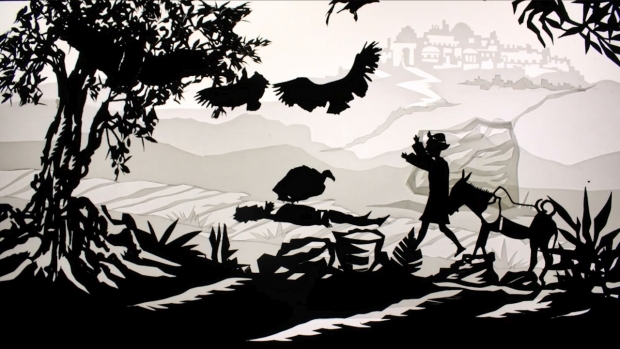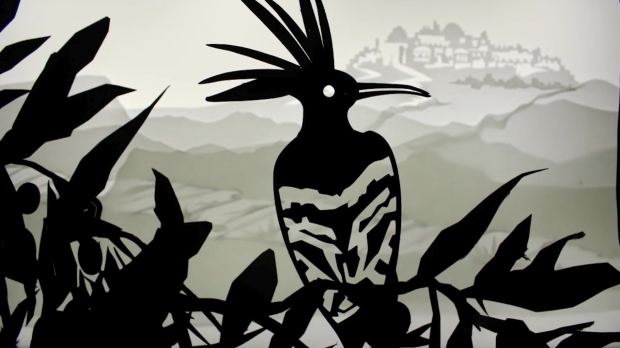Animator, illustrator, and teacher Al Bohl uses paper cut-out silhouette animation, pioneered a century ago by German filmmaker Lotte Reiniger, to tell the timeless – and timely - story of a stranger who helps a man laying beaten and bleeding on the side of the road.
From educator and author to minister and musician, Al Bohl has enjoyed a wide range of creative career paths, though all roads seem to lead him back to illustration and animation, which he considers his primary passions.
“Some people see things in numbers and words, and other people see in pictures. That’s always been me.”
Bohl was in his 30s when he first started looking to publish his “Zaanan” comic books, which chronicled a rising hero in a futuristic world governed by an evil computer. He eventually met Al Hartley, known for his work on “Archie Comics.” Hartley became his mentor, referring publishing house Barbour and Company to Bohl for illustration work. Barbour came on as publisher of “Zaanan,” launching Bohl into the first 14 years of his full-time illustration career. The artist has now been in the industry for 50 years and, in addition to the “Zaanan” saga, has illustrated over 50 books, including “The Pilgrim’s Progress,” and created a publishing company of his own – Owl and Bowl Press (now also Owl and Bowl Films) – with his son Aaron.
Bohl also created his own YouTube channel dedicated to demonstrating chalk art, produced animated short films such as The Hole Story and The Cat’s Meow, and created the Gen4 Animation Course in Bossier Parish public schools through the Talented Arts Program, which he taught for eight years. Though Bohl is technically retired, he says he’s “far from over,” best exemplified by his newest film, The Esteemed Priority, a stop-motion animated project using silhouette puppets.
The short will debut on the 2024 film festival circuit and has been selected for the Global Film Exhibition (Monday, January 15 to Monday, January 29), is a semi-finalist at the Berlin Shorts Awards (Friday, February 9 to Sunday, February 11), an award-winner at the Indie Short Film Festival in Los Angeles (Saturday, April 13), an award nominee for Best Senior Film at Cannes (Tuesday, May 14 to Saturday, May 25), and more (additional dates to be announced).
Check out the trailer:
“A lot of people write me and ask, ‘I want to get into animation or book illustrations. What should I do?’ and I say, ‘Do a lot of stuff for nothing,’” explains Bohl. “Because everything can go on your portfolio and be used as a way to network and meet people. It's awesome to try to find a way to help someone else. It'll also help you.”
 Doing something for nothing, and building a life dedicated to helping people, is the basis of Bohl’s latest short film, The Esteemed Priority, which tells the story of a stranger who helps a man who lays beaten and bleeding on the side of the road. It’s a story, which may be familiar to some, about unconditional love and unexpected kindness. It’s also a story that, in Bohl’s words, is “both timeless and timely.”
Doing something for nothing, and building a life dedicated to helping people, is the basis of Bohl’s latest short film, The Esteemed Priority, which tells the story of a stranger who helps a man who lays beaten and bleeding on the side of the road. It’s a story, which may be familiar to some, about unconditional love and unexpected kindness. It’s also a story that, in Bohl’s words, is “both timeless and timely.”
“When you're going to invest a year and a half of your life in something, it's best to make sure it's something you really believe in,” notes Bohl. “It’s got to have a message you think is important, which I do. Poverty, pollution, battered women… these things are everywhere, and it really gets me upset. And I’ve spent a lot of time trying to research the best ways to continue to help solve these problems, because the worst thing I could do is nothing.”
The message of The Esteemed Priority is summed up at the end of the film, which notes the importance of three words: See, Feel and Do. In other words, Bohl’s message to the viewer is to observe the world, see the pain, and do something about it.
“This also seemed like a good conversation to have considering everything that’s happened in Israel and Gaza,” notes Bohl. “In the film, the beaten man is Jewish, and he’s helped by a man whose people have historically been enemies of the Jews. If there was ever a time when the message of unconditional love between these two groups of people was needed, it’s now.”
He continues, “It’s not enough to see that there’s hurt, prejudice, and racism, and to just feel bad about it. We need to do something to reverse it. And the only thing that reverses hate is love.”
This isn’t a profound concept. The “Golden Rule” to “treat others as you’d want to be treated” is one of the first social skills taught to children. Yet, it’s a concept so much of the world has forgotten and needs to re-learn. The Esteemed Priority is taking people back to their roots, and not just in lessons in kindness but also in the history of animation.
Using methods pioneered by German film director and silhouette animator Lotte Reiniger, Bohl works in stop-motion with paper cut-out puppets; limbs are hinged together with metal paper fasteners, manipulated by hand on a brightly lit trick box, or trick table.
“I actually used Reiniger’s exact method,” explains Bohl. “There are still people who do silhouette animation, but they do it with CGI. They don't actually use the paper cutouts. But I moved all 10,000 frames by hand.”
Known for creating the oldest surviving feature-length animated film, The Adventures of Prince Achmed, in 1926, Reiniger is also known, from 1923 to 1926, for building the first form of a multiplane camera, an innovative device used in traditional animation where different pieces of artwork are moved past the camera at various speeds and at various distances from one another. This creates a sense of parallax or depth and is the reason why the light table on which these scenes are filmed is referred to as a “trick” table.
 “The table I have is similar to the one Reiniger and her husband spent three years building together,” notes Bohl. “I have 12 low-heat lightbulbs installed in an enclosed box with a glass top and a camera overhead. If I want to have a character, or city, or something far off in the distance, then that goes on the first piece of tracing paper. Then, to make it closer, you make it a little darker by putting another piece of that same cut-out design on top of the other, and we do that until it gets darker and darker and appears closer and closer. You’ll put a piece of glass over that to make sure it doesn’t move or rustle, and then you’ll bring in your characters to move across the screen. That's how you get your depth of field with this type of animation. It’s also how you can show different color ranges.”
“The table I have is similar to the one Reiniger and her husband spent three years building together,” notes Bohl. “I have 12 low-heat lightbulbs installed in an enclosed box with a glass top and a camera overhead. If I want to have a character, or city, or something far off in the distance, then that goes on the first piece of tracing paper. Then, to make it closer, you make it a little darker by putting another piece of that same cut-out design on top of the other, and we do that until it gets darker and darker and appears closer and closer. You’ll put a piece of glass over that to make sure it doesn’t move or rustle, and then you’ll bring in your characters to move across the screen. That's how you get your depth of field with this type of animation. It’s also how you can show different color ranges.”
In The Esteemed Priority, birds of various silhouette depths flutter across the screen, creating an almost hallucinating effect. Strips of light, practically clear paper are scattered and haphazardly moved around over a character’s mouth to represent them drinking water. One of the most enchanting scenes in the short is when the stranger bandages up the wounded man with strips of cloth, showcasing a bit of a texture not seen up to that point in the film. It’s a welcomed, tactile experience that adds to the tangibility of the story.
“We took a little piece of gauze and pulled it and separated itself so it wouldn’t be too tight and would show the light well,” Bohl explains. “But it took a long time to find the best way to position the character and what to cut out and what to leave to get the best look in that one little scene. The whole thing is a labor of love, in many ways.”
Amazingly, while he now teaches animation to many students and aspiring artists, all the animation techniques Bohl knows are self-taught. He has helped students become proficient in Claymation, 2D animation, and cut-out stop-motion, but his preferred method is silhouette storytelling, and now that he’s retired, Bohl gets to dive in fully to a medium he’s studied diligently.
“My students and I did 150 to 300 films each year and worked with every kind of animation style, but I studied Reiniger’s method, in particular, in a lot of depth,” admits Bohl. “I probably have 10 books on her and have been studying her filmmaking for the last decade. I love the ability to control the animation and how it moves at such a steady pace. You don’t get action fatigue with this.”
Bohl is no longer teaching the Gen4 classes, but he still looks for chances to guide the next generation of animators, including his granddaughters, Emma (10), Eva (6), and Amelie (5), who all worked on his latest film.
“They helped with some of the movements across the screen, like when the stranger goes to get the Jewish man some water,” notes Bohl. “They had fun doing it, which gave me a lot of joy.”
In fact, along with messages of love, active kindness, and change-making, Bohl has another nugget of wisdom he hopes The Esteemed Priority can impart on viewers. “Creativity has no age limit,” he shares. “Too many people my age are looking for a place to sit down. That’s just not in me.”











